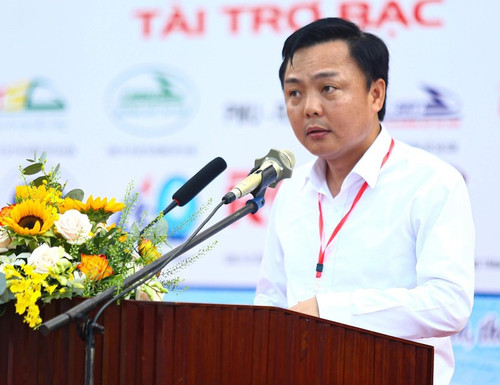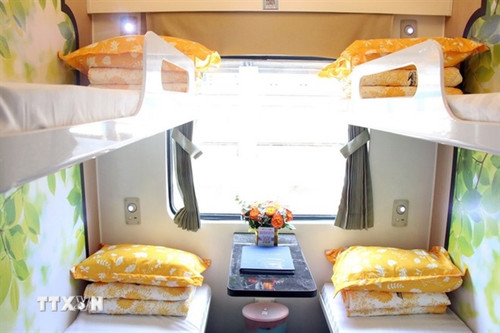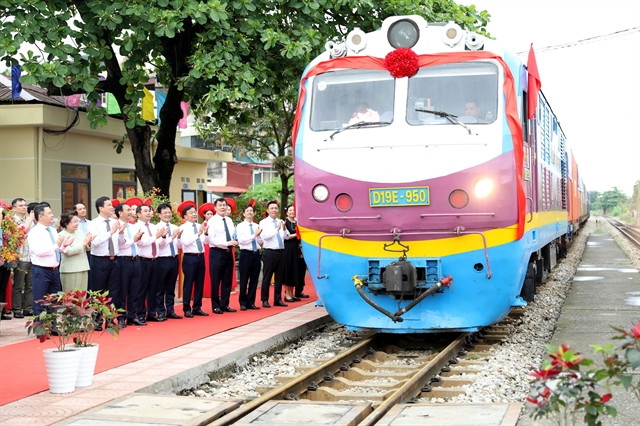Hoang Gia Khanh, General Director of Vietnam Railway Corporation (VNR), has granted an interview to Nhan Dan Newspaper to talk more about the railway industry’s effort to innovate its operation to chug along with passengers’ needs and achieve better performance
Question: Why did the VNR decide to elevate Cao Xa — which was just a small station on the Hanoi-Hai Phong rail route — to an international freight station?
VNR General Director Hoang Gia Khanh: On May 2, a train consisting of 12 containers carrying sulphur, aluminium, and milk departed from Cao Xa Station in Cam Giang District, Hai Duong Province, to Yen Vien Station in Hanoi to connect with international intermodal trains for export to China.
On May 20, as planned, Hai Duong Province will export the first shipment of lychees from Cao Xa Station, marking an important milestone towards turning Cao Xa into an international freight station in the future.
Following Kep Station in Bac Giang Province, Cao Xa is the second station to undergo renovations and upgrades under the VNR’s decision.
Cao Xa Station was formerly a class 4 station, with only 3 railway lines and 1 small-scale cargo yard. It served as a place of giving way to trains and loading and unloading goods, for
 |
| VNR General Director Hoang Gia Khanh |
the transportation of domestic goods such as fertiliser and cement, with a low volume of rail freight. Goods in Hai Duong were not imported or exported directly by rail because the local cargo yards did not have adequate qualification to handle containers.
However, Cao Xa Station has favourable position as it is about 50km from Yen Vien Station in Hanoi, making it convenient for the organisation of international railway transport routes to China and other countries through the Lao Cai and Dong Dang border gates.
Therefore, VNR proposed to the functional authorities to fully utilise the railway line while expanding the road and waterway transportation system that connects to the station.
Cao Xa Station has undergone renovations and upgrades since January 2024. In the second phase, if approved, VNR will continue to upgrade Cao Xa Station as an international intermodal station, meeting conditions for duty-free business, warehouses, and customs clearance.
Recently, the VNR launched several high-quality tourist train services, which have received much appreciation and interest from passengers. Is this a new direction of VNR to attract passengers?
In late March, VNR put into operation the high-quality tourist train service SE19/20 named ‘Connecting Heritages in Central Region’, linking Hue City in the central province of Thua Thien - Hue and with nearby Da Nang City.
During the three-hour train journey, passengers can admire the magnificent natural beauty along Hai Van Pass, dubbed Vietnam’s most marvellous wonder.
Those who take trips in the morning or the afternoon can enjoy the spectacular sunrise or sunset scenes on Lang Co Bay, one of the most beautiful bays in the world.
From the train, passengers can see marvellous landscapes, with the Truong Son Mountain Range on one side and the deep blue sea on the other.
In mid-April, we opened the night train route named ‘Da Lat night journey’, providing passengers with fresh experiences of admiring the beauty of Da Lat City at night. Da Lat – Trai Mat route is the only unique cog railway in Vietnam serving tourists visiting Da Lat city.
 |
| Amenities inside a four-bed cabin on the newly-inaugurated Ho Chi Minh City - Da Nang train service include Wi-Fi, air-conditioning, reading lights, charging ports, and comfortable bedding. (Photo: VNA) |
Most recently, at the end of April, a luxury train service has been launched from Ho Chi Minh City to Da Nang.
The trains feature a fresh exterior paint scheme in white, grey and blue, and interiors have been redesigned to provide more spacious and comfortable accommodation. They also feature amenities such as Wi-Fi, air-conditioning, reading lights, charging ports, new mattresses, blankets, sheets, pillows, and curtains.
A private two-bed cabin is available for those seeking added privacy, and restroom facilities have been upgraded to improve the passenger experience.
The launch of high-quality train services is part of VNR’s effort to enhance the passenger experience during their train journeys. These new products have gained enthusiastic response from passengers and tour operators, as the number of rail passengers have increased dramatically, and tickets on these route have been fully sold out.
Many people think that the railway sector has already fully exploited its potential. Do you think that there is still room for further development in the railway sector?
I think that it is not an exaggeration to say that the railway's potential is unlimited. Vietnam railways has a history of nearly 150 years, the railway network stretches nearly 3,150km long, passing through 34 provinces and cities, with more than 300 stations.
We hope that a train journey is not only for travelling but also a way of experiencing and promoting the image of the country.
VNR General Director Hoang Gia Khanh
Last year, The British travel guide Lonely Planet has named The Reunification Express — Vietnam’s north-south railway — as one of the most incredible rail trips in the world. The railway stretches for more than 1,726 kilometres between the country’s two biggest cities of Hanoi and Ho Chi Minh City over the course of two days.
In addition to fulfil the task of transporting passengers and goods, we want to enhance the travel experience of passengers.
We hope that a train journey is not only for travelling but also a way of experiencing and promoting the image of the country. We want to turn the trains into mobile “check-in” venues and the stations into destinations for culture, art, history, and heritage.
We have nurtured many plans to further unlock the railway’s potentials. One of them is to cooperate with international partners to deploy many new and unique products in the near future.
Thank you so much for your sharing!
The Government has issued Resolution No 178/NQ-CP on an action plan for implementing the Politburo’s Conclusion No 49-KL/TW on the development orientation of Vietnam's railway transport to 2045.
The action plan sets out tasks including perfecting institutions and policies, completing railway planning and related plans and mobilising resources to invest in rail transport.
















